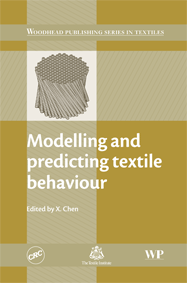Jan 4 2010
Textiles form a material widely used in both domestic and industrial applications. Differing assembly methods, composition and composite formations shape special features of textiles that need to be recognised to fully utilise the material. The prediction of textile behaviour has been the focus of a considerable amount of discussion and research over the past few years to explore the nature of the problems caused by differing features.

Modelling and predicting textile behaviour from Woodhead Publishing provides an overview of the different types of models and methods that can be used successfully within the textile industry. An overview of the structural hierarchy in textile materials forms the basis of the introduction with a proceeding chapter accessing fundamental modelling of textile fibrous structures.
The modelling of yarn, woven, nonwoven and knitted materials are accessed with an examination of the strengths and limitations associated with the models and how specific models are applied in different situations. The scope of the book is further extended with the inclusion of a discussion of modelling, simulation and control of textile properties and modelling of the colour properties of textiles.
With its distinguished editor and international range of contributors, Modelling and predicting textile behaviour is essential reading material for textile technologists, fibre scientists and textile engineers. However, this book will also be an important information source in an academic setting.